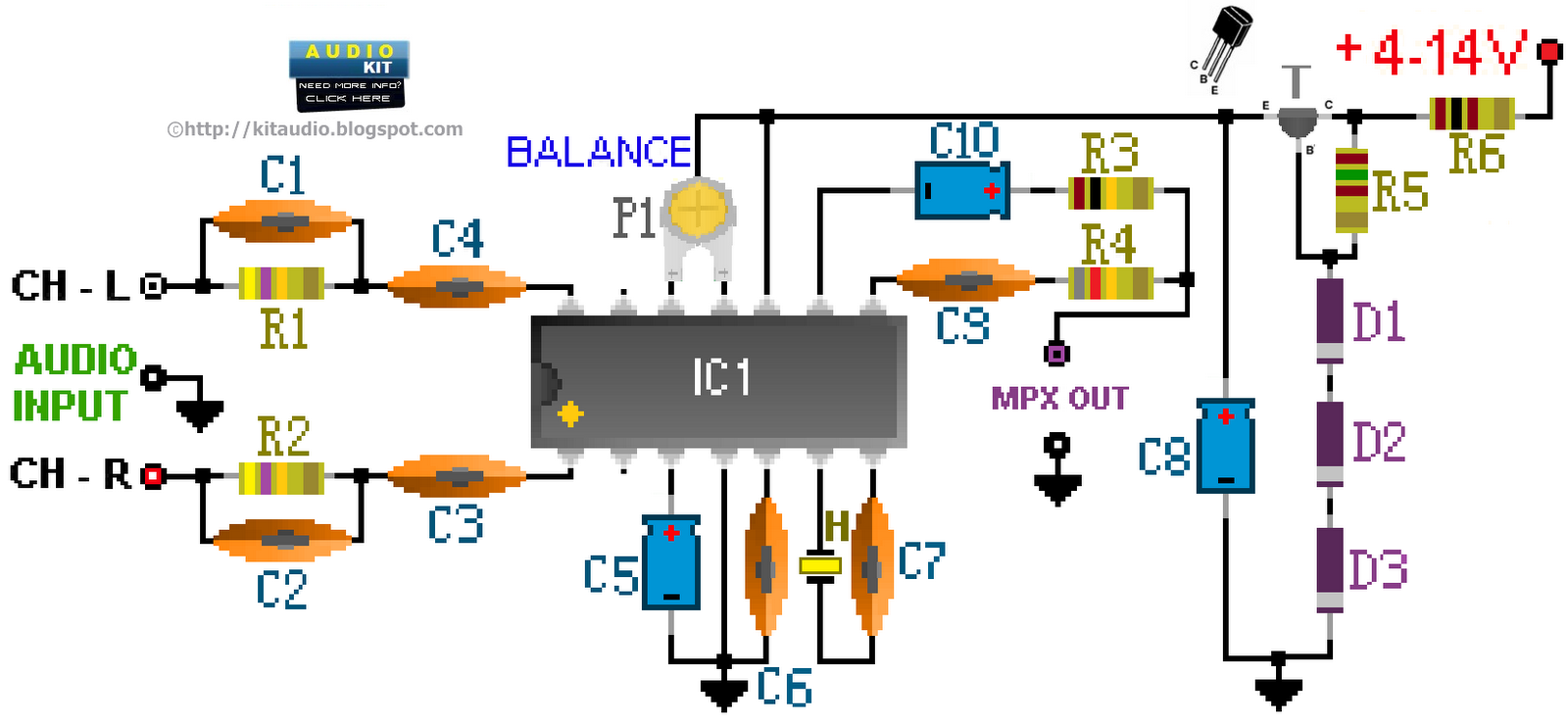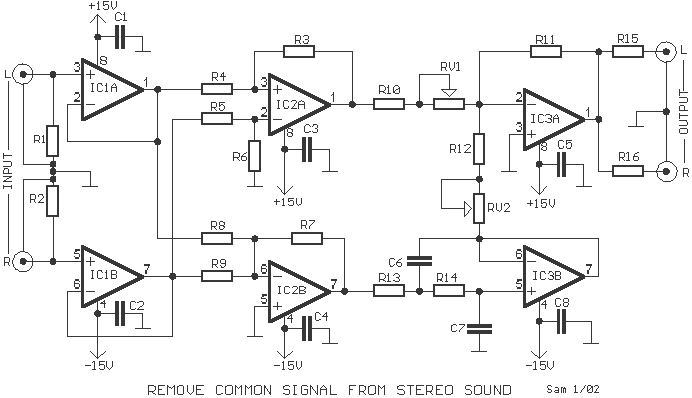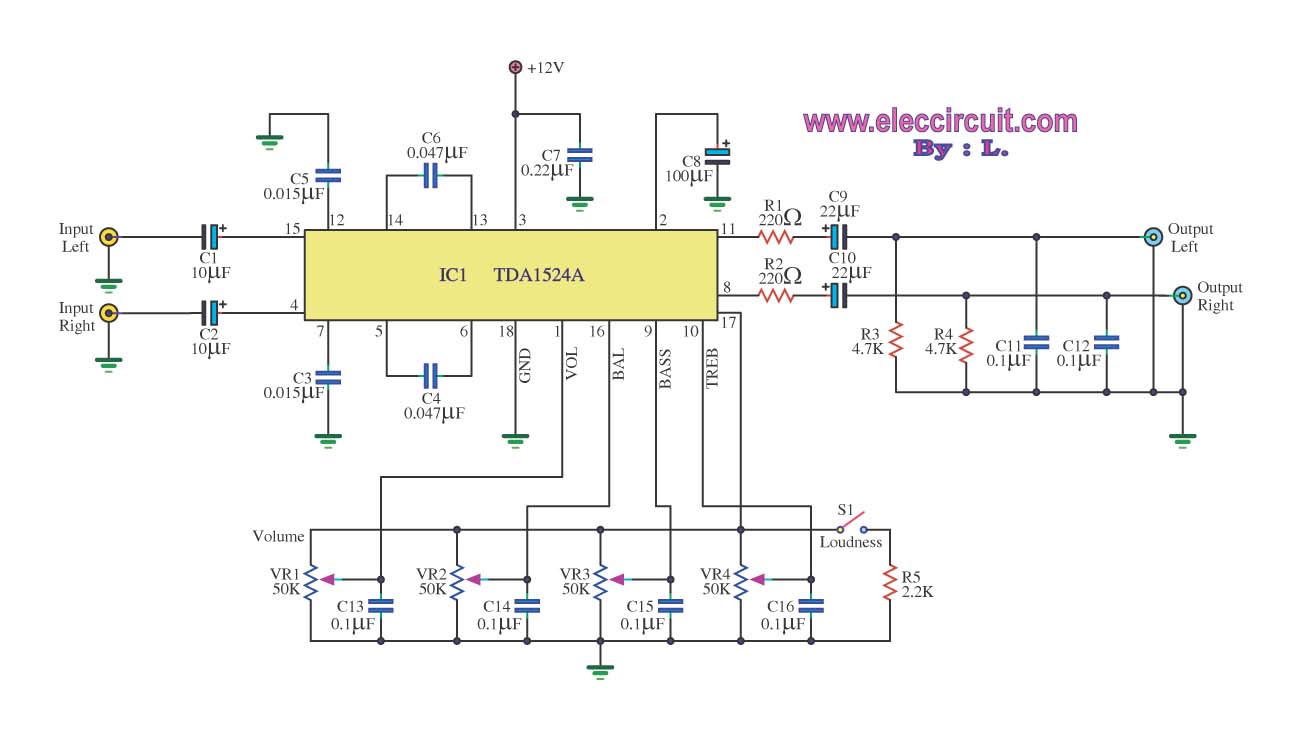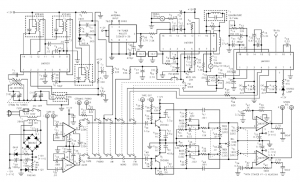
hi fi stereo multiplexer for fm

A left and right audio source is first pre-emphasized using a high-pass filter and then fed into adder circuits. The output of one adder is the sum of the two signals, resulting in the L + R signal (the monaural signal), while the other adder produces the difference of the two signals, or L - R. The L - R signal is applied to a balanced modulator along with a 38 kHz signal. The output of this balanced modulator is a double-sideband suppressed carrier amplitude modulation (DSBSC AM) signal centered at 38 kHz. A portion of the 38 kHz signal is frequency-divided to create a 19 kHz tone, and all three signals are combined in a summary/adder circuit at the output of the generator. The L + R signal, which includes baseband frequencies from near 0 Hz to 15 kHz, occupies that part of the frequency spectrum. The 19 kHz tone acts as a pilot sub-carrier signal, which will assist in the demodulation of the received signal at the receiver. The L - R signal, modulated by the 38 kHz tone using DSBSC, occupies the frequency range from 23 to 53 kHz. In frequency modulation (FM), noise increases with modulation frequency. To address this, FM communication systems utilize a noise-reduction system of pre-emphasis and de-emphasis. Pre-emphasis enhances the amplitude of higher modulating frequencies before modulation, following a well-defined high-pass filter curve. This added amplitude helps make higher frequencies more resistant to noise by increasing their modulation index. De-emphasis, performed at the receiver using a low-pass filter, counteracts this effect. The NJM2035 is an integrated circuit designed to generate a stereo composite signal and output a 19 kHz pilot signal from two input audio signals and a 38 kHz crystal oscillator, along with a few external capacitors and resistors. This stereo encoder provides a high-quality stereo sound transmission at a low cost, producing crystal-clear audio and excellent channel separation that rivals more expensive stereo encoders on the market. Its performance is attributed to the 38 kHz quartz crystal controlling the 19 kHz pilot tone, eliminating the need for calibration or readjustment of the circuit. The NJM2035 is manufactured by NJR CORPORATION (JRC), a subsidiary of New Japan Radio, which is recognized as a leading manufacturer of high-end professional audio semiconductors. This transmitter is compatible with any mono FM transmitter available on the market. When constructing the stereo encoder, it is crucial to take time and verify all connections against the schematic to ensure accuracy.
The audio processing circuit described utilizes a systematic approach to achieve stereo sound transmission through modulation techniques. Initially, the left and right audio signals undergo pre-emphasis to enhance their high-frequency components, which is critical for maintaining audio clarity and reducing noise susceptibility during transmission. The use of high-pass filtering allows for the selective amplification of frequencies above a certain threshold, improving the overall signal-to-noise ratio.
The adder circuits play a vital role in generating the L + R and L - R signals. The L + R signal, which combines both audio channels, forms the basis for the monaural output, while the L - R signal allows for the extraction of differential audio information, which is essential for stereo sound reproduction. The balanced modulator then takes the L - R signal and the 38 kHz carrier frequency to create a DSBSC AM signal. This modulation technique is efficient as it suppresses the carrier, allowing for a more effective use of bandwidth.
The generation of the 19 kHz pilot tone is crucial for the demodulation process at the receiver end, facilitating the recovery of the original audio signals. The frequency division of the 38 kHz signal to produce the 19 kHz tone ensures that the receiver can accurately synchronize with the transmitted signal, enhancing the fidelity of the audio output.
The NJM2035 integrated circuit is a significant component in this system, providing a compact and effective solution for stereo signal generation. Its design incorporates the necessary functionalities to produce a high-quality audio output without the complexity associated with traditional stereo encoders. The use of a quartz crystal for frequency stabilization further enhances the reliability of the system, ensuring consistent performance over time.
In conclusion, this audio processing circuit exemplifies modern techniques in FM transmission, utilizing pre-emphasis, DSBSC modulation, and integrated circuitry to deliver high-quality stereo sound efficiently. The careful design and implementation of each stage of the circuit contribute to its overall effectiveness in audio signal transmission.A Left and Right source of audio are first pre-emphasized (HPF) and then fed to adder circuits. The output of one adder is the sum of the two signals, or the L + R signal (the monaural signal), and the output of the other adder is the difference of the two signals, or L R. The L R signal is applied to a balanced modulator along with a 38-k Hz signal. The output of the balanced modulator is a DSBSC AM signal centered at 38 kHz. A portion of the 38-kHz signal is divided in frequency to become 19 kHz, and all three signals are applied to a summary/adder circuit at the output of the generator. The L + R signal, which contains baseband frequencies from near 0 Hz to 15 kHz, occupies that portion of the frequency spectrum.
The 19-kHz tone is pilot sub-carrier signal, which will be used at the receiver to aid in the demodulation of the received signal. The L R signal, which has been DSBSC amplitude modulated by a 38-kHz tone, occupies the frequency range from 23 to 53 kHz.
In FM, the noise increases with modulation frequency. To compensate for this effect, FM communication systems have incorporated a noise-combating system of pre-emphasis and de-emphasis. Pre-emphasis provides increased amplitude to the higher modulating frequencies prior to modulation under a well-defined pre-emphasis (high-pass filter) curve.
This added amplitude will serve to make the higher frequencies more immune to noise by increasing their index of modulation. De-emphasis is just the opposite operation (using a low-pass filter) and it is done at the receiver. The NJM2035 is an integrated circuit used to generate a stereo composite signal and obtain switching out and 19Khz pilot signal due two input audio signal and 38Khz X-tal and few external CR.
This stereo encoder is the perfect solution for those looking for a high quality stereo sound transmission at a low cost. This stereo encoder produces an excellent crystal clear stereo sound and very good channel separation that can match with many more expensive stereo encoders that are available on the market.
It is all possible thanks to a 38KHz quartz crystal that controls the 19kHz pilot tone, so you will never have to calibrate or re-adjust the circuit. NJM2035 offers superb quality and is manufactured by NJR CORPORATION (JRC), a subsidiary of New Japan Radio, a company that is known as the world`s best manufacturer of high end professional audio semiconductors.
This transmitter will work with any mono FM transmitter which are available on our website. While building your stereo encoder please take your time and always double check with the schematic to make sure that all the connections are done correctly. If you have any questions, comments or suggestion we will be glad to further assist you. 🔗 External reference
The audio processing circuit described utilizes a systematic approach to achieve stereo sound transmission through modulation techniques. Initially, the left and right audio signals undergo pre-emphasis to enhance their high-frequency components, which is critical for maintaining audio clarity and reducing noise susceptibility during transmission. The use of high-pass filtering allows for the selective amplification of frequencies above a certain threshold, improving the overall signal-to-noise ratio.
The adder circuits play a vital role in generating the L + R and L - R signals. The L + R signal, which combines both audio channels, forms the basis for the monaural output, while the L - R signal allows for the extraction of differential audio information, which is essential for stereo sound reproduction. The balanced modulator then takes the L - R signal and the 38 kHz carrier frequency to create a DSBSC AM signal. This modulation technique is efficient as it suppresses the carrier, allowing for a more effective use of bandwidth.
The generation of the 19 kHz pilot tone is crucial for the demodulation process at the receiver end, facilitating the recovery of the original audio signals. The frequency division of the 38 kHz signal to produce the 19 kHz tone ensures that the receiver can accurately synchronize with the transmitted signal, enhancing the fidelity of the audio output.
The NJM2035 integrated circuit is a significant component in this system, providing a compact and effective solution for stereo signal generation. Its design incorporates the necessary functionalities to produce a high-quality audio output without the complexity associated with traditional stereo encoders. The use of a quartz crystal for frequency stabilization further enhances the reliability of the system, ensuring consistent performance over time.
In conclusion, this audio processing circuit exemplifies modern techniques in FM transmission, utilizing pre-emphasis, DSBSC modulation, and integrated circuitry to deliver high-quality stereo sound efficiently. The careful design and implementation of each stage of the circuit contribute to its overall effectiveness in audio signal transmission.A Left and Right source of audio are first pre-emphasized (HPF) and then fed to adder circuits. The output of one adder is the sum of the two signals, or the L + R signal (the monaural signal), and the output of the other adder is the difference of the two signals, or L R. The L R signal is applied to a balanced modulator along with a 38-k Hz signal. The output of the balanced modulator is a DSBSC AM signal centered at 38 kHz. A portion of the 38-kHz signal is divided in frequency to become 19 kHz, and all three signals are applied to a summary/adder circuit at the output of the generator. The L + R signal, which contains baseband frequencies from near 0 Hz to 15 kHz, occupies that portion of the frequency spectrum.
The 19-kHz tone is pilot sub-carrier signal, which will be used at the receiver to aid in the demodulation of the received signal. The L R signal, which has been DSBSC amplitude modulated by a 38-kHz tone, occupies the frequency range from 23 to 53 kHz.
In FM, the noise increases with modulation frequency. To compensate for this effect, FM communication systems have incorporated a noise-combating system of pre-emphasis and de-emphasis. Pre-emphasis provides increased amplitude to the higher modulating frequencies prior to modulation under a well-defined pre-emphasis (high-pass filter) curve.
This added amplitude will serve to make the higher frequencies more immune to noise by increasing their index of modulation. De-emphasis is just the opposite operation (using a low-pass filter) and it is done at the receiver. The NJM2035 is an integrated circuit used to generate a stereo composite signal and obtain switching out and 19Khz pilot signal due two input audio signal and 38Khz X-tal and few external CR.
This stereo encoder is the perfect solution for those looking for a high quality stereo sound transmission at a low cost. This stereo encoder produces an excellent crystal clear stereo sound and very good channel separation that can match with many more expensive stereo encoders that are available on the market.
It is all possible thanks to a 38KHz quartz crystal that controls the 19kHz pilot tone, so you will never have to calibrate or re-adjust the circuit. NJM2035 offers superb quality and is manufactured by NJR CORPORATION (JRC), a subsidiary of New Japan Radio, a company that is known as the world`s best manufacturer of high end professional audio semiconductors.
This transmitter will work with any mono FM transmitter which are available on our website. While building your stereo encoder please take your time and always double check with the schematic to make sure that all the connections are done correctly. If you have any questions, comments or suggestion we will be glad to further assist you. 🔗 External reference





